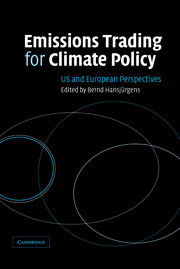Book contents
- Frontmatter
- Contents
- List of figures
- List of tables
- List of contributors
- Preface
- List of abbreviations
- 1 Introduction
- Part 1 Regulatory instruments for climate policy: theoretical aspects
- 2 Designing instruments for climate policy
- 3 Technical innovation and design choices for emissions trading and other climate policies
- 4 Incentives to adopt new abatement technology and US–European regulatory cultures
- Part 2 The US approach to pollution control: lessons for climate policy
- Part 3 European policies to control greenhouse gases: the EU directive on emissions trading
- 14 Concluding observations
- Index
- References
4 - Incentives to adopt new abatement technology and US–European regulatory cultures
Published online by Cambridge University Press: 22 September 2009
- Frontmatter
- Contents
- List of figures
- List of tables
- List of contributors
- Preface
- List of abbreviations
- 1 Introduction
- Part 1 Regulatory instruments for climate policy: theoretical aspects
- 2 Designing instruments for climate policy
- 3 Technical innovation and design choices for emissions trading and other climate policies
- 4 Incentives to adopt new abatement technology and US–European regulatory cultures
- Part 2 The US approach to pollution control: lessons for climate policy
- Part 3 European policies to control greenhouse gases: the EU directive on emissions trading
- 14 Concluding observations
- Index
- References
Summary
Introduction
There is a debate in the environmental economics literature on the firm's incentive to develop and adopt new abatement technologies under different policy instruments. While many economists would agree that incentive-based instruments such as environmental taxes and tradable permits provide superior incentives to invest in cost–saving abatement technologies compared to command-and-control type policies, some authors have challenged this view either by looking at specific groups of emitters (Malueg, 1989) or at different stages along the innovation chain (Fischer, this volume, ch. 3). Another debate concerns the relative ranking of economic instruments. In a series of papers several authors have claimed that economic instruments can be ranked from highest-incentive to lowest-incentive in the following order: (i) auctioned permits, (ii) emission taxes, (iii) grandfathered permits (Milliman and Prince, 1989, Jung et al., 1996). This view has occasionally been challenged (Buchholz, 1993, Schwarze, 2001, Requate and Unold, 2003) because it contradicts the fundamental equivalence theorem of auctioned and free permits in a setting that is not considering the use of public funds. Similarly, Laffont and Tirole (1994) have argued that permits could induce underinvestment in abatement R&D because of falling permit prices and perceived government racheting.
This chapter demonstrates that this debate reflects a general trade-off between the goal of stimulating new technology and the goal of dynamic efficiency.
- Type
- Chapter
- Information
- Emissions Trading for Climate PolicyUS and European Perspectives, pp. 53 - 60Publisher: Cambridge University PressPrint publication year: 2005



